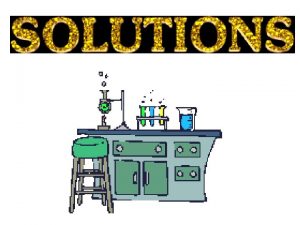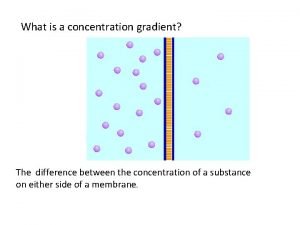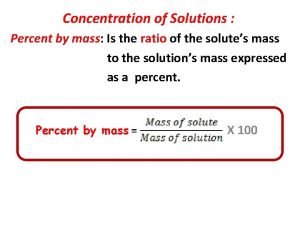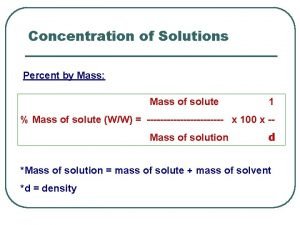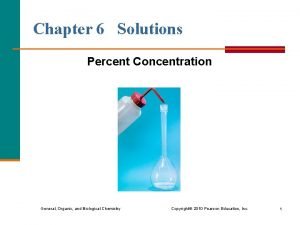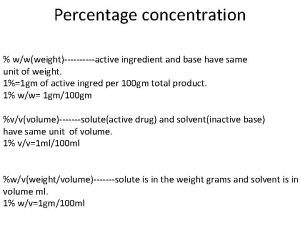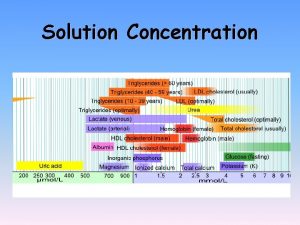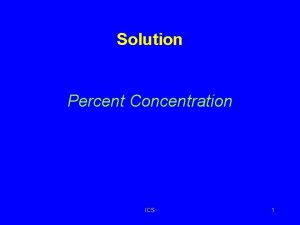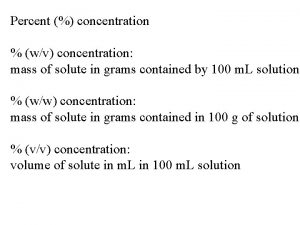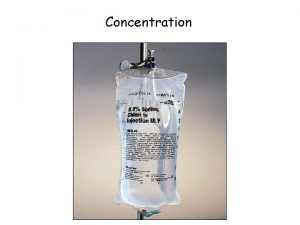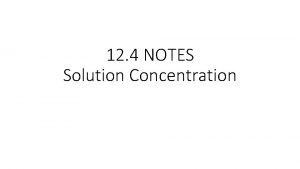Solution Concentration Mass percent mass partmass whole x




![Solution Stoichiometry • 581 m. L of 0. 342 M Barium nitrate [Ba(NO 3)2] Solution Stoichiometry • 581 m. L of 0. 342 M Barium nitrate [Ba(NO 3)2]](https://slidetodoc.com/presentation_image_h/303edcd5547de1c67921dcf4ee59443c/image-5.jpg)






- Slides: 11

Solution Concentration Mass percent • (mass part/mass whole) x 100(%) • An aqueous solution of acetic acid is 20 percent by weight Acetic acid has a density of 1. 0269 g/m. L. How many moles of acetic acid are contained in 35 m. L of this solution? Practice problem Tro – 4. 55

Solution Concentration Molarity (M) • Mole solute/ Liter solution • For Dilution -- M 1 V 1 = M 2 V 2 – A chemist wants to prepare 0. 25 M HCl. Commercial HCl is 12. 4 M. How many m. L of the concentrated acid does the chemist require to make up 1. 50 L of the dilute acid? Practice problems Tro – 4. 59 -4. 62

Solution Concentration Molarity (M) • Conversion of % to molarity – A 35. 0% solution of glucose (C 6 H 12 O 6) has a density of 1. 28 g/m. L. What is the molarity of the solution? Practice problems Tro – 4. 95 -4. 96

Solution Stoichiometry • Some sulfuric acid is spilled on a lab bench. It can be neutralized by sprinkling sodium bicarbonate on it and then mopping up the resultant solution. The sodium bicarbonate reacts with sulfuric acid as follows: • 2 Na. HCO 3(s) + H 2 SO 4(aq) Na 2 SO 4(aq) + 2 H 2 O(l) + 2 CO 2(g) • Sodium bicarbonate is added until the fizzing due to the formation of CO 2(g) stops. If 27 m. L of 6. 0 M H 2 SO 4 was spilled, what if the minimum mass of Na. HCO 3 that must be added to the spill to neutralize the acid?
![Solution Stoichiometry 581 m L of 0 342 M Barium nitrate BaNO 32 Solution Stoichiometry • 581 m. L of 0. 342 M Barium nitrate [Ba(NO 3)2]](https://slidetodoc.com/presentation_image_h/303edcd5547de1c67921dcf4ee59443c/image-5.jpg)
Solution Stoichiometry • 581 m. L of 0. 342 M Barium nitrate [Ba(NO 3)2] are mixed with 264 m. L of 0. 631 M potassium sulfate (K 2 SO 4). Write the molecular, ionic, and net ionic reactions for this reaction, calculate the mass of any precipitate produced and inventory the ions in solution after precipitation. Practice problems Tro – 4. 116

• A 35. 49 m. L sample of 0. 2430 M H 2 SO 4 is mixed with 65. 33 m. L of a 0. 4199 M sample of KOH. Determine the concentration of all ions in solution, the p. H, and p. OH. Remember p. H = -log [H 3 O+] = 10 -p. H p. OH = -log [OH-] = 10 -p. OH p. H + p. OH = 14 [H 3 O+][OH-]=10 -14 M 2

Titrations • A noncarbonated soft drink contains an unknown amount of citric acid, H 3 C 6 H 5 O 7. If 100. 0 m. L of the soft drink requires 33. 51 m. L of 0. 01024 M Na. OH to neutralize the citric acid completely, what is the concentration of citric acid in the soft drink in moles/liter (M)? In equivalents/liter (N)? Practice problems Tro – 4. 84, 4. 110

Titrations • Suppose you are given a 4. 554 g sample that is a mixture of oxalic acid, H 2 C 2 O 4, and another solid that does not react with sodium hydroxide. If 29. 58 m. L of 0. 5501 M Na. OH is required to titrate the oxalic acid in the 4. 554 g sample, what is the weight percent of oxalic acid in the mixture?

• An unknown solid acid is either citric acid or tartaric acid. To determine which acid you have, you titrate a sample of the solid with aqueous Na. OH and from this determine the molar mass of the unknown acid. A 0. 956 g sample was titrated with 29. 1 m. L of 0. 513 M Na. OH. The formulas for the acids are • Citric acid H 3 C 6 H 5 O 7 • Tartaric acid H 2 C 4 H 4 O 6

• The molar mass of a certain metal carbonate, MCO 3, can be determined by adding an excess of HCl acid to react with all the carbonate and then “back titrating” the remaining acid with a Na. OH solution. • Write the equations for these reactions • In a certain experiment, 20. 00 m. L of 0. 0800 M HCl were added to a 0. 1022 g sample of MCO 3. The excess HCl required 5. 64 m. L of 0. 1000 M Na. OH for neutralization. Calculate the molar mass of the carbonate and identify M.

Challenge Problem • A 19. 264 gram sample of a mixture of Mg. Cl 2 and Cs. Cl is dissolved in water and treated with excess Ag. NO 3 so that ALL the chloride precipitates as Ag. Cl. The mass of dried Ag. Cl is 43. 668 grams. Calculate the mass Cs. Cl in the sample.
 Cdc whole school whole community whole child
Cdc whole school whole community whole child Mass percentage of solution
Mass percentage of solution Concentration gradient
Concentration gradient Movement of high concentration to low concentration
Movement of high concentration to low concentration Percent concentration formula
Percent concentration formula How to calculate percent concentration
How to calculate percent concentration How to find percent concentration
How to find percent concentration Chemistry mass percent
Chemistry mass percent Percentage concentration
Percentage concentration Valid percent
Valid percent Part of a whole x 100
Part of a whole x 100 Monica yuskaitis
Monica yuskaitis

